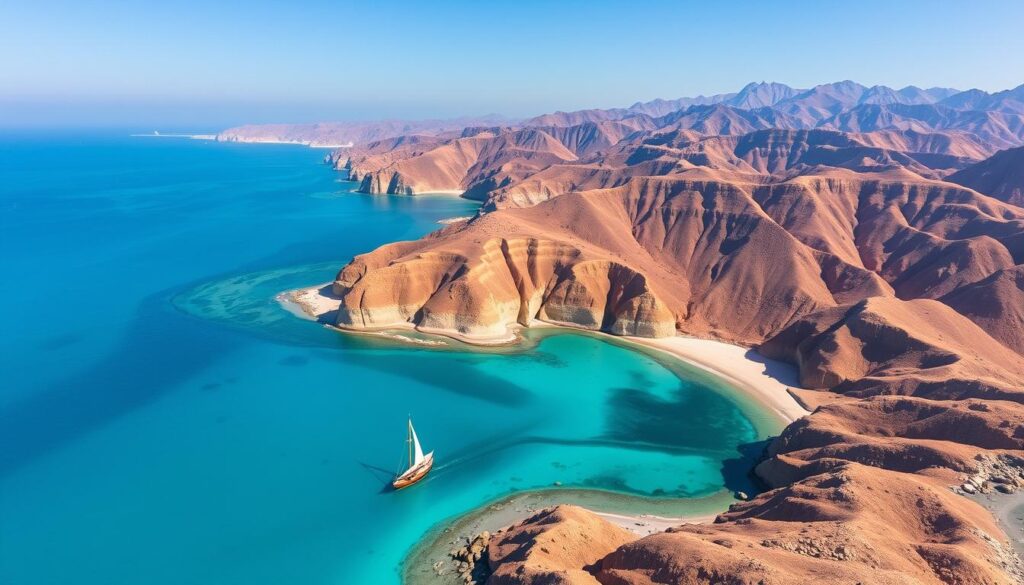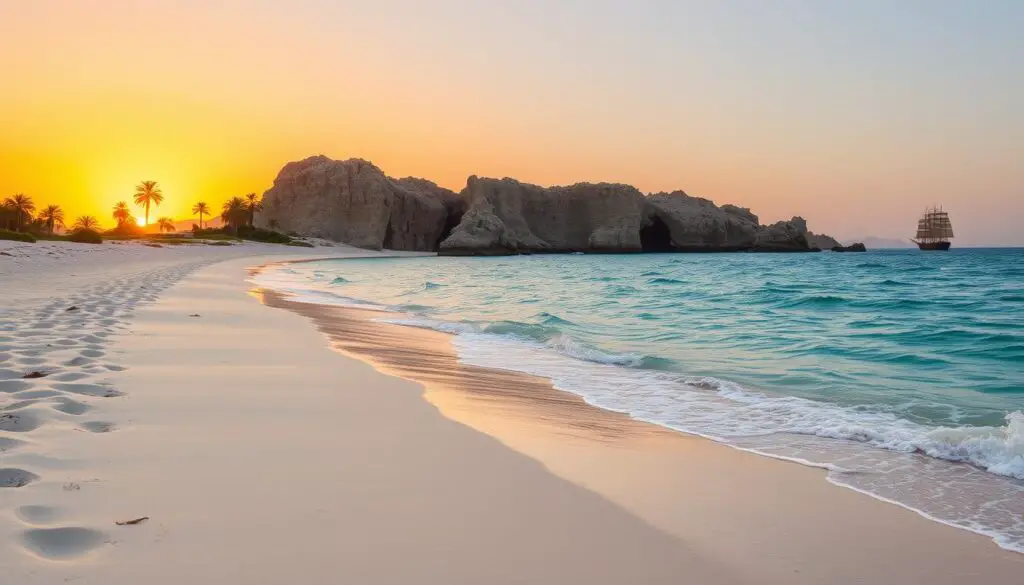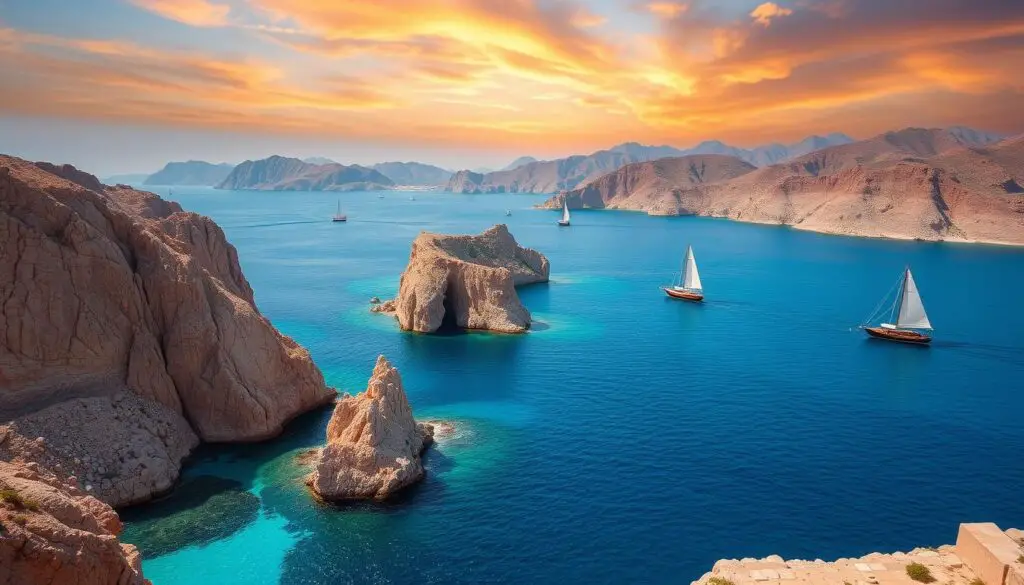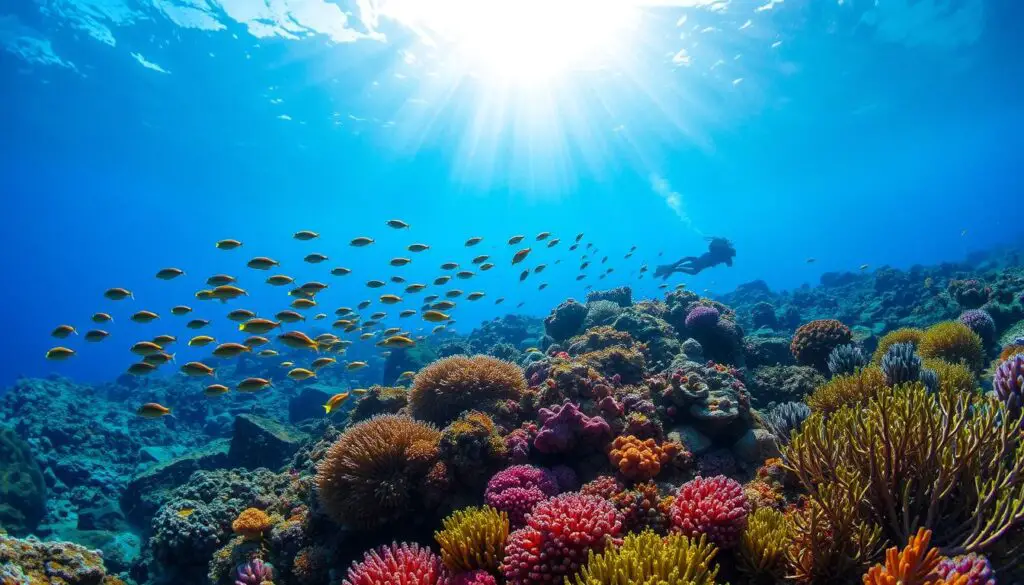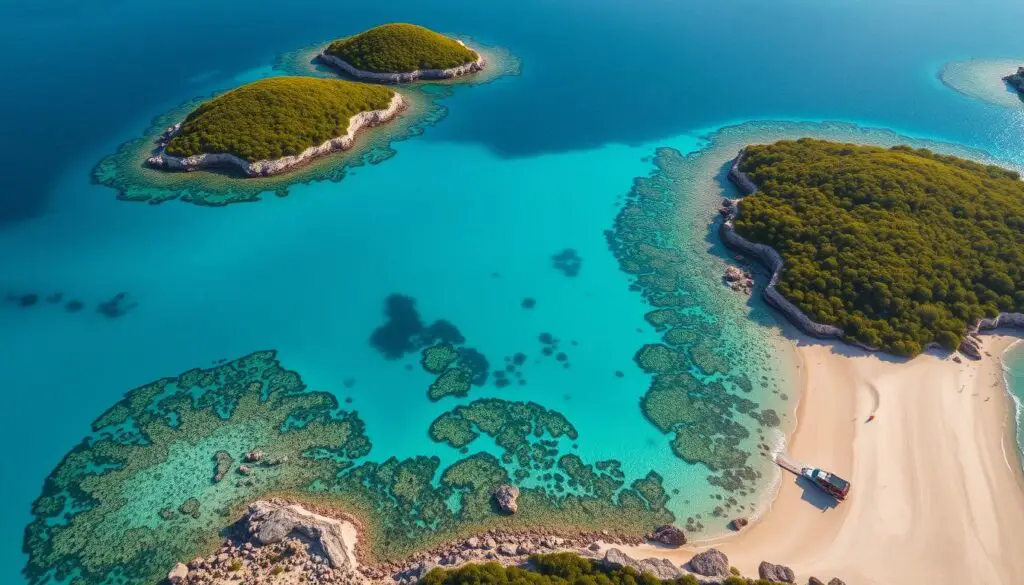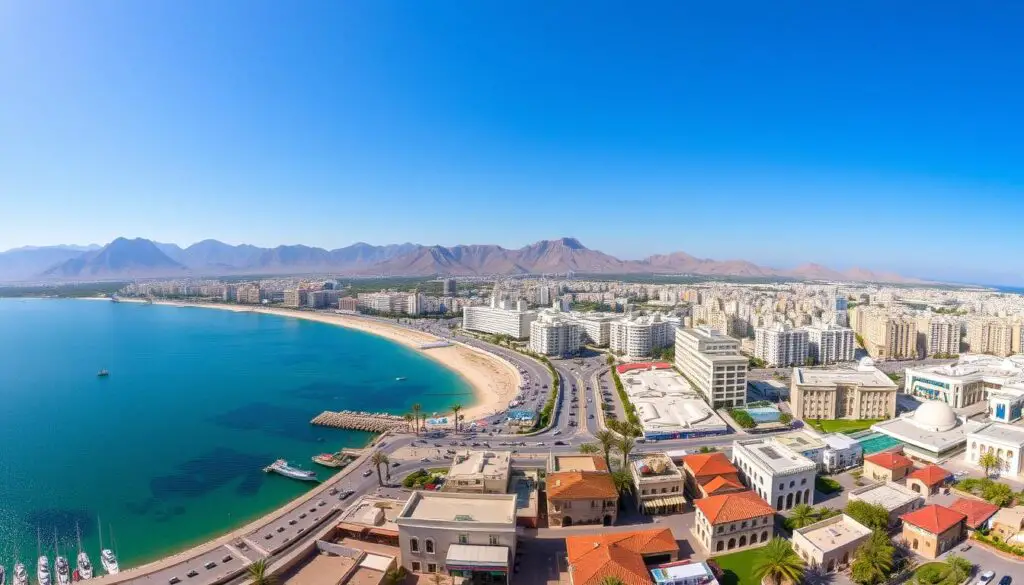Standing on Oman’s sun-kissed shores, I felt wonder and excitement. This country, on the Arabian Peninsula, has 3,165 kilometers of coastline. It’s a treasure waiting to be found. From Muscat’s busy heart to the Musandam Peninsula’s dramatic views, Oman’s coast is a mix of beauty, culture, and adventure.
Exploring Oman, I saw its diverse offerings. You can walk Muscat’s historic streets, see the Musandam Peninsula’s inlets, or dive in the Strait of Hormuz. Oman is where desert and sea meet, blending old traditions with new ideas.
Key Takeaways
- Oman boasts an impressive 3,165km of coastline, offering diverse landscapes and activities along the sun-drenched fringes.
- The Musandam Peninsula, often referred to as the ‘Norway of Arabia’, features a jagged network of coastal inlets best explored by boat.
- Muscat, the capital, sprawls along a coastline dotted with coves and serves as a gateway to Oman’s coastal wonders.
- Oman’s coastline is a mesmerizing blend of natural beauty, rich cultural heritage, and captivating outdoor adventures.
- Visitors can explore historic sites, marvel at the dramatic landscapes, and dive into the vibrant underwater world along Oman’s stunning coastline.
Discovering the Maritime Heritage of Muscat
Muscat, the capital of Oman, has a rich maritime history. It’s nestled between the Hajar Mountains and the Gulf of Oman. The city was once known as the “hidden port” by the Ancient Greeks.
It thrived as a trade hub from the 16th to 19th centuries. The Portuguese and the Omani Empire controlled it during this time.
The Hidden Port’s Historical Significance
Muscat’s harbor was hidden under cliffs. It was a key center for Indian Ocean trade. Merchants from all over came to trade, making Muscat a cultural melting pot.
The city’s architecture shows its maritime heritage. You can see Oman Beaches, Historic Forts, and Fishing Villages along the coast.
From Portuguese Trade Hub to Modern Capital
Muscat’s location made it valuable. It changed hands several times. The Portuguese ruled for over a century, making it a colonial outpost.
In 1970, Sultan Qaboos took power. He led Oman’s transformation into a prosperous nation.
The Legacy of Sultan Qaboos
The Sultan Qaboos Grand Mosque is a symbol of Oman’s renaissance. It opened in 2001. The mosque shows Oman’s commitment to its heritage and modernity.
Today, Muscat is a vibrant city. It blends its maritime past with a forward-looking vision. Visitors get a unique look into Oman’s coastal heritage.
| Tour Experiences | Duration | Highlights |
|---|---|---|
| Historical Muscat Tour | 1 hour | Explore the city’s hidden port and colonial-era landmarks |
| Modern Muscat Tour | 1 hour | Visit the stunning Sultan Qaboos Grand Mosque and other contemporary attractions |
| Comprehensive Muscat Tour | 2 hours | Experience both the historical and modern sides of Muscat |
“The Sultan Qaboos Grand Mosque is a true architectural marvel, showcasing the finest examples of Islamic design and craftsmanship. It’s a must-see for anyone visiting Muscat.” – Lonely Planet
Exploring the Dramatic Musandam Peninsula
The Musandam Peninsula is in Oman’s north, known as the “Norway of Arabia.” It’s separated from the rest of Oman by the United Arab Emirates. This area has rugged landscapes, a rich maritime history, and exciting Coastal Tourism.
The peninsula’s fjord-like inlets were shaped by centuries of erosion. Visitors can take traditional Dhow Cruises to see these waterways. They can also find hidden islands. The town of Kumzar has its own language, Kumzari, developed over hundreds of years.
For those who love Underwater Exploration, Musandam is a paradise. Its coastline has great spots for snorkeling and diving. Here, you can see dolphins, turtles, and even whale sharks. In 2023, the Oman Adventure Centre – Musandam opened, with the world’s longest zipline over water.
“Musandam’s dramatic landscapes and coastal wonders make it a true gem of Oman, offering a unique experience that blends adventure, culture, and natural beauty.”
Looking for adventure, culture, or just beautiful views? The Musandam Peninsula is a top spot for any coastal exploration in Oman.
| Key Facts about Musandam Peninsula | Details |
|---|---|
| Geographical Isolation | Musandam Peninsula is 100 kilometers away from the rest of Oman, separated by the United Arab Emirates. |
| Smuggling Activities | Musandam smuggling activities included contraband crossings over the Strait of Hormuz during the late twentieth century, a tolerated part of life in the region. |
| Unique Language | Kumzar, a town in Musandam, has its own unique language, Kumzari, developed over hundreds of years of isolation. |
| Ancient Rock Art | Musandam peninsula features petroglyphs, ancient works of rock art, depicting camels, people on horseback, and spears. |
| Adventure Activities | The ‘mountain safari’ activity in Musandam includes trips up Jebel Harim, the highest peak in the region. |
Marine Life and Underwater Wonders in the Strait of Hormuz
The Strait of Hormuz, between the Persian Gulf and the Sea of Oman, is a treasure trove for underwater explorers. This narrow passage connects the Middle East to the Indian Ocean. It’s a home to a variety of marine life, including colorful coral reefs and massive whale sharks.
Diving Among Coral Reefs
Oman’s waters are famous for their diving spots, with the Strait of Hormuz being a top choice. Divers can see a world of colors as they explore the coral formations. They’ll meet many reef fish, turtles, and other marine animals. The water is clear, making for an unforgettable dive.
Whale Sharks and Marine Biodiversity
The Strait of Hormuz is a great place to see whale sharks, especially from September to November. These huge fish are gentle and can be seen swimming in the waters. Oman’s coast is also home to 1,078 species of coastal fish, many found nowhere else.
Traditional Dhow Experiences
For a unique experience, try a Dhow Cruise along the Strait of Hormuz. These traditional boats have sailed these waters for centuries. They offer a glimpse into Oman’s maritime history. As you sail, you’ll see beautiful coastlines and maybe even marine life.
Whether you dive, love wildlife, or just want a memorable trip, the Strait of Hormuz in Oman is a must-see. It promises an underwater adventure you won’t forget.
The Al Dimaniyyat Islands: Oman’s Hidden Paradise
Nestled an hour from Muscat, the Al Dimaniyyat Islands are a hidden gem along Oman’s stunning Oman Beaches. This archipelago of nine uninhabited islands, known as the “Maldives of Oman,” was officially designated a nature reserve in 1996. This move was to protect its diverse marine life and turtle population.
The islands boast Coastal Tourism offerings like pristine white sand beaches, crystal-clear turquoise waters, and world-class snorkeling and Underwater Exploration opportunities. Rare indigenous birds, such as ospreys, migrate to the area, making it a haven for nature enthusiasts.
- The Daymaniyat Islands are an archipelago of nine small uninhabited islands located off the coast of Oman in the Arabian Sea.
- The islands are situated approximately 42 kilometers from Muscat, the capital of Oman.
- The Daymaniyat Islands were officially designated as a protected nature reserve in 1996.
| Island Name | Area (sq km) | Highest Elevation (m) |
|---|---|---|
| Daymaniyat Island | 2.6 | 73 |
| Sila Island | 1.2 | 56 |
| Musalallah Island | 0.8 | 48 |
The islands are known for their rocky limestone terrain, white sandy beaches, and diverse marine life. This includes whale sharks and a significant number of sea turtles that nest there. Between May and October is the best time to spot these gentle giants around the Al Dimaniyyat Islands.
“The Al Dimaniyyat Islands offer some of the best snorkeling and diving opportunities in the Middle East. You can encounter a variety of marine species like Arabian butterflyfish, red sea clownfish, and Arabian angelfish.”
Boat tours are the primary mode of transport to access the Al Dimaniyyat Islands, with trips departing from the harbor in Muscat. Tour operators typically offer day trips to the islands. They provide services such as transportation, visitor permits, snorkel gear, meals, and guidance on the best spots for marine life sightings.
Oman’s Stunning Coastline: Muscat and the Gulf of Oman
Muscat, the capital of Oman, has a coastline that mixes old charm with modern beauty. It invites visitors to explore its rich maritime history. The beaches along the Gulf of Oman offer a mix of relaxation and cultural experiences.
Coastal Architecture and Historical Sites
The coastline of Muscat is home to architectural marvels that tell the city’s story. The Muttrah Fish Market is a lively spot that shows the area’s long maritime history. Close by, the Al Alam Palace, the Sultan’s ceremonial home, highlights Oman’s royal past.
Don’t miss the Muttrah Souk, a maze of alleys near the corniche. It’s filled with traditional goods and souvenirs.
Beach Tourism and Water Activities
The Gulf of Oman’s beaches are perfect for relaxing and water sports. From October to March, the weather is great and the beaches are less crowded. You can swim, snorkel, kayak, or paddleboard, all while enjoying Oman’s beautiful shores.
Cultural Experiences Along the Shore
For a deep dive into Oman’s maritime history, try a dhow cruise along the coast. These traditional boats offer a unique view of the country’s seafaring past. You can see local fishing and pearl diving traditions up close.
These experiences let you connect with Oman’s coastal heritage. They help you understand the country’s long maritime legacy.
Masirah Island: Adventure Sports and Wildlife Haven
Masirah Island is a hidden treasure off Oman’s southeastern coast. It’s the largest island in Oman, stretching over 60 kilometers long and 12 kilometers wide. The island is home to diverse landscapes, including vast dunes, lush mangroves, rugged terrains, and palm-lined lagoons.
Thrill-seekers will love Masirah Island for its kitesurfing and windsurfing. The island’s winds are perfect for these sports, reaching 20 knots during the monsoon. The waters are calm and have great waves, making it ideal for these activities. Birdwatchers will enjoy the Khawr Rawri Lagoon, where they can see flamingos and over 400 migratory bird species.
Masirah Island is also a turtle lover’s paradise. It’s a key spot for Loggerhead and Green Sea Turtles to nest. The island’s varied landscapes, including mangroves and salt flats, are perfect for photographers and nature lovers.
Getting to Masirah Island is easy, with a 2.5-hour ferry ride from Shannah Port or a 45-minute flight from Muscat. It offers a unique Travel experience, combining Coastal Tourism and Underwater Exploration. Whether you’re into water sports, wildlife, or just nature, Masirah Island has something for everyone.
“Masirah Island is a true hidden gem, offering a perfect balance of adventure, wildlife, and natural beauty. It’s a must-visit destination for anyone seeking an unforgettable Middle East travel experience.”
Traditional Maritime Culture and Dhow Heritage
Oman’s maritime history is tied to the dhow, a traditional wooden sailing boat. These boats have sailed the Arabian Sea for centuries. They were built in Sur and were key to Oman’s economy, helping with trade and exploration.
Ancient Navigation Methods
Dhow captains and crews used old navigation methods. They used the wind, currents, and stars to navigate. Their knowledge of the sea helped them sail through dangerous waters with skill.
Modern Coastal Tourism
Today, dhows are important in Oman’s Middle East Travel scene. They offer Dhow Cruises and visits to Fishing Villages. These trips let visitors see Oman’s maritime history up close.
| Type of Dhow | Purpose |
|---|---|
| Al Boom | Long-distance voyages |
| Al Shasha | Coastal fishing |
| Al Houri | Racing or short trips |
Keeping Oman’s dhow-building alive is important. These boats are made with old techniques and quality materials. Visiting the Dhow Yard in Sur lets travelers see this heritage up close.
“Oman’s maritime culture is deeply rooted in its history, with traditional dhows playing a crucial role. These wooden vessels offer various experiences, from sunset cruises along Muscat’s coastline to full-day excursions with opportunities for snorkeling and dolphin watching.”
The Coastal Mountains: Where Desert Meets Sea
Oman’s Arabian Peninsula coastline is stunning. The Hajar Mountains rise from the plains to 3,000 meters. This mix of desert and sea offers a unique experience.
Exploring this area is best by 4×4 through Wadi Bani Awf. The drive is thrilling, with amazing views. You’ll also see traditional villages like Bilad Sayt, where you can learn about Oman’s culture.
The Hajar Mountains are not just beautiful. They are also home to historic forts like Nakhal and Nizwa. These forts tell the story of Oman’s past, showing its history and defenses.
| Average Daytime Temperatures | Solo Travelers | Single Supplement |
|---|---|---|
| Late 20s to early 30s degrees Celsius | Approximately 70% of clients | Available but not compulsory |
“The Hajar Mountains form a dramatic backdrop to Oman’s coastline, rising to 3,000m from the coastal plains.”
The coastal mountains of Oman are unforgettable. They offer stunning landscapes, cultural experiences, and exciting 4×4 adventures. Here, the Arabian Peninsula, Coastal Tourism, and Muscat Attractions come together in a breathtaking way.
Conclusion
Oman’s stunning coastline along the Gulf of Oman offers a wide range of experiences. Travelers from all over the world are drawn to it. From Muscat’s historical port to the Musandam Peninsula’s dramatic landscapes, Oman’s beauty and heritage are unmatched.
Visitors can dive into Oman’s rich culture, explore its untouched beaches, and see its amazing underwater sights. They can also admire the architectural wonders along the coast. Oman’s efforts to protect its coast and traditions make it a top choice for those looking for real and eco-friendly travel.
When planning your trip to Oman, make sure to find the hidden treasures along its stunning coastline. From Muscat’s lively souks to the peaceful wadis and green oases, Oman’s coast is a true marvel. It shows the country’s deep history, natural splendor, and commitment to green tourism.
